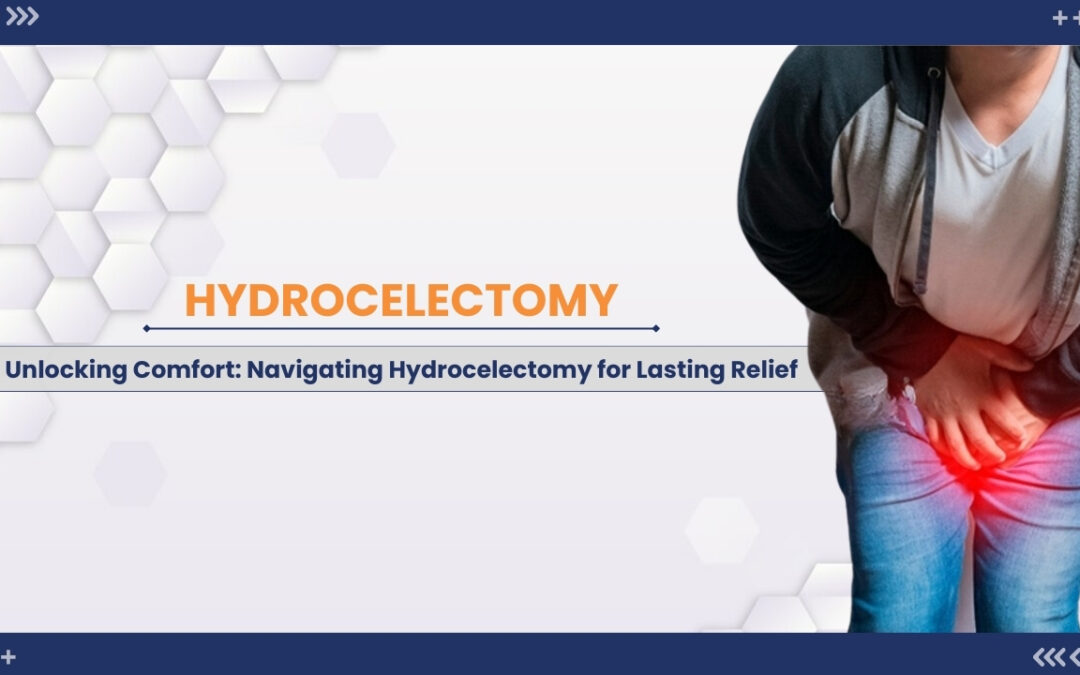COMPREHENSIVE GUIDE TO HYDROCELECTOMY: UNDERSTANDING THE PROCEDURE
Hydrocelectomy is a surgical procedure designed to treat the accumulation of fluid in the scrotum, known as hydrocele. Discover the reasons, benefits, and recovery process associated with this surgery. Our expert insights shed light on the importance of Hydrocelectomy, providing a clear understanding of the procedure. If you’re considering or undergoing Hydrocelectomy, our guide offers valuable information for an informed decision. Learn about risks, expected outcomes, and post-operative care. Navigate the world of Hydrocelectomy with confidence, ensuring a smooth journey towards recovery and optimal well-being.
WHAT IS A HYDROCELE AND WHEN IS HYDROCELECTOMY RECOMMENDED?
Unraveling the mystery of hydrocele – a condition marked by fluid buildup in the scrotum. In our concise guide, learn about the causes, symptoms, and when Hydrocelectomy becomes the recommended solution. Hydrocelectomy, a surgical procedure, addresses this discomfort, providing relief and restoring normalcy. Dive into our informative content to grasp the indications for Hydrocelectomy, ensuring you make informed decisions about your health. Discover the importance of timely intervention and the transformative impact of Hydrocelectomy on your well-being. Empower yourself with knowledge on when to consider this surgical solution for a hydrocele-free future.
TYPES OF HYDROCELECTOMY
Hydrocelectomy, the surgical procedure aimed at resolving hydroceles, primarily manifests in two distinct types: open hydrocelectomy and sclerotherapy or aspiration.
Open Hydrocelectomy:
This traditional approach involves making an incision in the scrotum or lower abdomen to directly access the hydrocele. The surgeon drains the accumulated fluid, repairs any underlying issues causing the hydrocele, and may remove excess tissue if necessary.
Sclerotherapy or Aspiration:
In some cases, a less invasive option involves draining the fluid from the hydrocele using a needle (aspiration) and injecting a sclerosing agent to promote the closure of the sac. While this method avoids a formal incision, it may be less effective for larger hydroceles or those caused by certain factors.
Indications and Diagnosis
In the realm of Hydrocelectomy, understanding the indications and diagnosis is paramount for a targeted and effective surgical approach. Indications often manifest through noticeable scrotal swelling and discomfort, prompting a closer examination. A comprehensive diagnosis involves medical history review, physical examination, and imaging studies to confirm the presence of a hydrocele. Indications for Hydrocelectomy become apparent when conservative measures prove ineffective, or if the hydrocele causes persistent discomfort or affects daily activities. This section of the surgical process explores the nuanced signs that guide medical professionals in recommending Hydrocelectomy, ensuring a tailored and precise intervention for optimal patient outcomes.
DIFFERENT APPROACHES TO HYDROCELECTOMY: SURGICAL OPTIONS
Explore tailored solutions for Hydrocelectomy with our insights into diverse surgical options. Our blog highlights different approaches, from traditional open surgery to minimally invasive techniques like laparoscopy and needle aspiration. Discover the benefits and considerations of each method, ensuring informed decisions for your health. Dive into this guide for a concise overview of Hydrocelectomy surgical options, empowering you with knowledge on personalized treatments for optimal outcomes. Uncover the nuances of each approach and navigate your journey towards a hydrocele-free future with confidence.
SURGICAL PROCEDURE OF HYDROCELECTOMY:
Hydrocelectomy is a surgical procedure designed to alleviate the discomfort and swelling caused by the accumulation of fluid in the scrotum. The process typically begins with the administration of either general or local anesthesia, ensuring the patient’s comfort throughout the surgery. A small incision is then carefully made in the scrotum or lower abdomen, providing access to the hydrocele. The surgeon proceeds to drain the accumulated fluid, relieving the associated symptoms.
Once the fluid is removed, a thorough evaluation of the underlying cause of the hydrocele takes place. Any identified abnormalities, such as persistent connections between the abdomen and scrotum, are addressed and repaired during the procedure. The incision is then meticulously closed with stitches, often of the dissolvable variety to streamline the recovery process.
Postoperatively, patients may receive scrotal support to aid in healing. This comprehensive approach ensures the effective resolution of the hydrocele while minimizing discomfort and promoting a smooth recovery for the individual undergoing hydrocelectomy.
POTENTIAL RISKS AND COMPLICATIONS OF HYDROCELECTOMY
It’s crucial to be aware of potential risks and complications associated with this surgical procedure. While Hydrocelectomy is generally considered safe, like any surgery, it carries some inherent risks. These may include infection, bleeding, or adverse reactions to anesthesia. Scrotal swelling or pain and fluid accumulation are common postoperative issues, albeit usually temporary. Rare complications such as damage to blood vessels or testicular structures may occur. It’s essential to discuss these potential risks with your healthcare provider before making an informed decision about Hydrocelectomy. Our blog delves into the nuances of these complications, providing valuable insights to ensure you approach the procedure with a comprehensive understanding of the potential risks involved, promoting a smoother recovery and optimal outcomes.
CONCLUSION:
In conclusion, Hydrocelectomy emerges as a transformative solution for those grappling with the discomfort of a hydrocele. Through this comprehensive guide, we’ve navigated the nuances of the surgical process, from indications and diagnosis to varied surgical options. Understanding the potential risks and complications arms you with the knowledge needed for an informed decision.


